Mandu
Mandu (City of Joy) is a small city in the state of Madhya Pradesh in India, now best known for a fort built by Baaz Bahadur in the memory of his queen Rani Roopmati. Between 1401 and 1561 it was the capital of a Muslim state in the north of India. The capital was abandoned more than 400 years ago, and it's now a small city but also home to a large ruins site more than 10 km long and 15 km wide. The temple dedicated to Shiva also attracts many pilgrims.
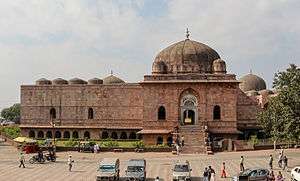
Get in
Indore (95 km) has the nearest airport and railhead. Ratlam (124 km) located on the Delhi - Mumbai rail route is another option of getting into Mandu
By plane
Ahilyabai Holkar Airport in Indore is the nearest airport. There are regular flights from Delhi, Mumbai, Pune, Jaipur, Hyderabad, Bhopal, Ahmedabad, Nagpur, Raipur and Kolkata
By bus
Mandu is well connected from Indore (95 km) and Dhar (35 km). From Indore there are two direct bus to Mandu, the first from Gangwal Bus Stand (08:00) and second from Sarawate Bus Stand (14:00). The journey takes 3 hours.
Alternatively one can make a break journey at Dhar. There are regular bus service from Indore to Dhar and from Dhar to mandu.
By car
You can rent a car in Indore. The best route from Indore is as follows: Indore - Pithampur - Ghatabillod - Labour - Dhar - Mandu. The distance is approximately 95 km and the roads are in good condition.
Get around
Apart from a few isolated ruins the runs of Mandu are clustered around a small area.
Walk
Most of the sites of Mandu can be covered by foot.
Bicycles
Can be hired to visit even the scattered sites of Mandu.
Car
Can be hired, and are is easiest and quickest way to visit the ruins of Mandu
Guides
Guides are available for whole sightseeing tours but most of these guides operate on a fixed circuit. Most of the major locations have guides at the spot.
See
.jpg)

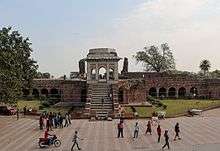
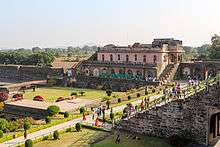

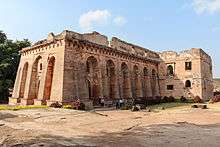
.jpg)
.jpg)
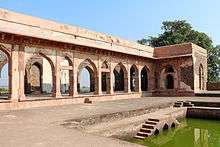
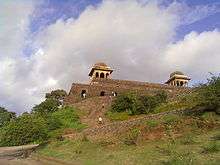
.jpg)
.jpg)
The archaeological sites of Mandu can be classified in five broad groups:
- Central Group
- Royal Group
- Rewa Kund Group
- Darya Khan's Tomb Group
- Sagar Talao Group
Apart from these major groups there are several scattered archaeological sites all over Mandu. There are also several gateways leading to the fortified medieval settlement of Mandu.
Central Group
As the name suggests, the Central Group is located at the very centre of the fortified citadel of Mandu. Today it serves as the main centre of Mandu town and houses its main bus stop. It is also refereed to as the Village Group. It has four archaeological sites, Ashrafi Mahal (along with the tomb of Mahmud Khilji), Jami Masjid and Hoshang Shah's Tomb. There are also two new temples. One of them is a Jain Temple, while the other is a Ram Temple.
- 🌍 Ashrafi Mahal and Mahmud Khalji's Tomb, Opposite Jami Masjid. Located opposite the Jami Masjid. The Ashrafi Mahal, probably served as a madarsa (Islamic school), adjacent to the Mosque, during the reign of Mahmud Khilji (1436 - 69). With the passage of time the Ashrafi Mahal has been reconstructed and extended several times and also have been used for several other purposes. Even the central open courtyard of the madarsa was later used for the construction of the massive tomb of Mahmud Khalji. The tomb has long collapsed. Today the Ashrafi Mahal is approached through a long flight of stairs and through a marble pavilion. The dome that crowned the pavilion has long collapsed. A passageway from the pavilion leads to a open courtyard, which once housed the tomb of Mahmud Khalji. The courtyard is lined with small cells on all four sides. The cells probably served as living quarters of students. On the four corners were minarets and during the reign of Mahmud Khalji, the minarets at the north west corner was converted into victory tower, to celebrate his victory over the Rana of Chittoor. The tower also has long collapsed and its foundation is all that remains to this day. Incidentally the Rana of Chitoor also built a victory tower, which stands to this day.
- 🌍 Jami Masjid (Opposite Ashrafi Mahal). A largest and the chief mosque of Mandu. The construction of the mosque began during the reign of Hoshang Shah and was completed by Mahmud Khalji. The Jami Masjid in Mandu was modeled after the Mosque of Damascus. It is approached through a huge domed gateway on the east. The door has marble jams and lintel, which probably are reminiscent of Hindu architecture. A passageway through the gate leads to a open courtyard with flanked on three side (except west) by pillared halls, most of which have long collapsed. Straight ahead on the western side is a main prayer hall crowned with three gigantic domes, along with 58 small domes. The paryer hall consisting of an amazing amalgamation of pillaars and arches have 17 curved niches on the western wall. The elaborately decorated central marble niche serves as the main mihrab of the mosque. Just next to the main mihrab is a domed pulpit, approached by a flight of stairs. The imam lead the prayers from this pulpit.
- 🌍 Tomb of Hoshang Shah (Behind or west of Jami Masjid). Completed in 1440 the Hoshang Shah's tomb is the first marble structure of India. The tomb is housed in a walled complex with entrance on the northern side. On the eastern side of the complex is a pillared hall. The Tomb of Hoshang Shah is located at the center of the complex and stands on a square raised platform. Above the roof is a slightly raised platform with battlement styled edges. It is slightly smaller than the roof and houses the massive marble dome in the centre. At the four corners of the platform are four smaller domes. The entrance to the tomb is through a arched gateway on the north. The gate way is flanked by two smaller arches with decorative marble screen. The southern wall also has similar archways but all of them have decorative marble screens. At the centre of the hall stands the cenotaph of Hoshang Shah (the original grave is located below, within the platform). It is a marble structure and is built is step pyramid style. It is flanked on both side by few more cenotaphs, one the western side there is one while on the eastern side there are two. It is said that Hoshang Shah Tomb inspired the Taj Mahal. Shah Jahan's architect supposedly went to Mandu to study the tomb's architecture before building the Taj Mahal. Chief architect Hamid left an inscription on the left hand side of the arched entrance, mentioning about their visit, which can still be seen to this day.
Royal Group
- 🌍
Jahaj Mahal (Ship Palace) (Sandwiched between Manju and kapoor Talao). Sunrise - Sunset. The 110 m long and 15 m broad double - storeyed building is located on a narrow strip of land between the Munj Talao and Kapur Talao, giving the appearance of a ship in water. probably built by Sultan Ghiyathuddin Khalji in the later part of the 15th century. It served as a large harem for the sultan and accommodated a staggering 15,000 women. Later it also served as the residence of Noor Jahan, the favourite queen of Mughal Emperor Jahangir.
- The southern end of the double - storied building has a stairs leading directly to the terrace. The northern end of the terrace contains a swimming pool of floral design there is a similar pool just below it on the first floor. The terrace has two domed pavilion on the southern and northern end of the long Jahaz Mahal. The northern pavilion is not at the very end of the terrace but just south of the swimming pool. The pavilions still contain blue and yellow tiles.
- 🌍 Hindola Mahal (Swinging Palace) (North of Jahaz Mahal). The T - shaped building with sloping buttressed walls probably served as an audience hall. It was built during the reign of Sultan Ghiyathuddin Khalji in the later part of 15th century.
- 🌍
Royal Palace and Champa Bawdi. West of the Hindola and north of Munj Talao is the royal palace. It is in ruins. At the entrance of the royal palace is the Champa Bawdi (Bawdi means step well), it is relatively in good condition. The railing around the Champa Bawdi is a recent addition by Archaeological Survey of India (ASI). Subterranean passage connects the base of the well to a series of vaulted rooms, thus keeping them cool during the scorching summer.
- North of the Champa Bawdi is the hammam (cold and hot water bath) complex, star and crescent shaped holes in the domed roof allow natural light to filter inside the dark interiors of the hammam.
- 🌍 Dilwara Khan's Mosque. The 1405 built Dilwara Khan's Mosque is the oldest Islamic structure of Mandu. It is located on the northern end of the Royal enclave and is the only religious structure in the Royal enclave.
- 🌍 Jal Mahal (Water Palace).
- 🌍 Munj Talao (A large lake on the western side of Jahaz Mahal).
- 🌍 Kapoor Talao (A lake on the eastern side of Jahaz Mahal).
- 🌍 Gada Shah's Shop.
- 🌍 Adheri Bawdi (Dark Step Well).
- 🌍 Ujawala Bawdi (Illuminated Step Well).
- 🌍 Taveli Mahal.
- 🌍 Nahar Jharokha.
Rewa Kund Group
Darya Khan's Tomb Group
Sagar Talao Group
Do
Buy
Eat

Restaurant for regular Indian fare at Malwa Resort - close to the Jami Masjid.
Traditional daal-baati may be savoured at the Jain Temple.
Try the local delicacies of Malwa region, daal-bafla and daal-paniya
- Shivani Restaurant, Main Rd, ☎ +91 72922 63202. While the quality and hit-and-miss, it does serve dishes from the local region including Dal Bafla.
Drink
- Baobab juice. The baobab tree, of African origin, grows in abundance in Mandu. Locally it is known as mandu ka imli. The flesh of the baobab fruit is dried and powdered. The powder is mixed in water with a dash of sugar to produce the juice. It's a sour drink and especially refreshing during summer. Rs 20.
- Nimboo pani. Nimboo pani (Indian-style lemonade), which is very popular and easily available, is a refreshing, tasty drink found everywhere in Mandu. Rs 10.
Sleep
- Temple in front of Jami Masjid. The Temple in front of Jami Masjid provided a reasonable-priced stay as of Dec 2009 (₹250 at that time), good for night stay for those who don't want AC or a deluxe room.
- Jhira Bagh Palace. Thirty kilometers from Mandu is a town called Dhar, where there is an old palace, Jhira Bagh Palace. It has been restored and converted into a hotel. This is a very good place to stay and the food is simply outstanding.
- The Rest House. Similar rooms.
For hotels, MP Tourism offers excellent options (booking available online). Mandu also has a number of good private hotels:
- 🌍 Malwa Resort. Run by MP Tourism. 20 cottages - 10 AC and 10 non AC
- 🌍 Malwa Retreat. Run by MP Tourism. 8 rooms - 2 AC and 6 non AC
- 🌍 Hotel Roopmati.
- Hotel Royal Palace (Near Jami Masjid), ☎ +91 99 77 078671.
- 🌍 Jahaz Mahal Hotel, Dhar Road, Mandu, Dist. Dhar Madhya Pradesh (India)- 454010, ☎ +91 7292 263272. A private hotel on the eastern banks of Sagar Talao
- 🌍 ASI Guest House, Taveli Mahal, Royal Enclave, ☎ +91 755 2558250.
Go next
- Maheshwar (41 km)
- Omkareshwar (89 km)
- Indore (99 km)
- Hanuwantiya